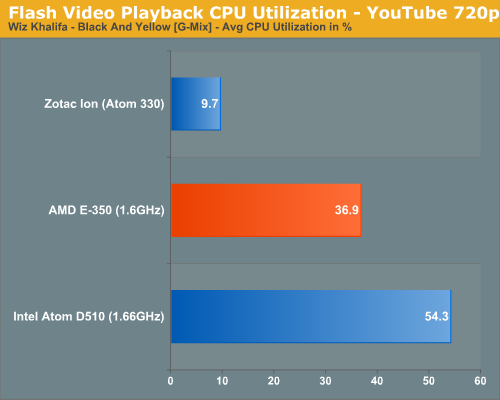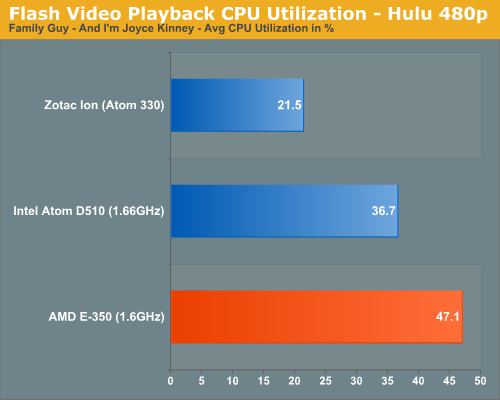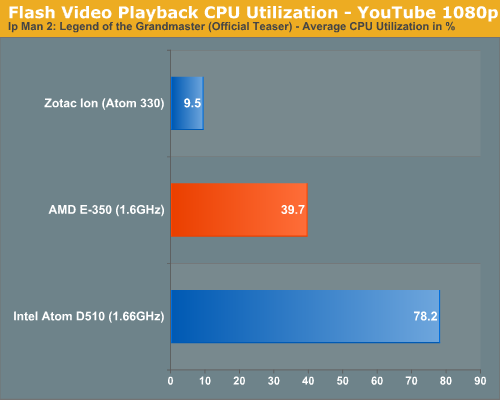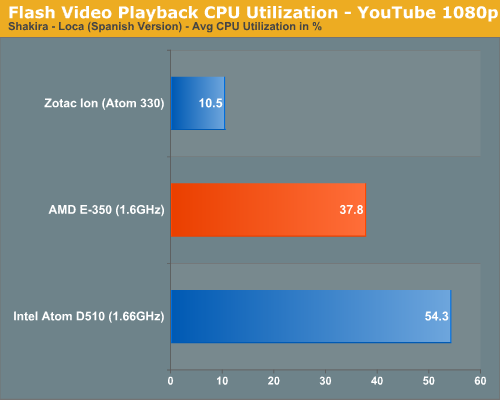The Brazos Review: AMD's E-350 Supplants ION for mini-ITX
by Anand Lal Shimpi on January 27, 2011 6:08 PM ESTBlu-ray & Flash Video Acceleration
Compatibility is obviously a strongpoint of Brazos. So long as what you’re decoding can be hardware accelerated you’re pretty much in the clear. But what about CPU utilization while playing back these hardware accelerated formats? The CPU still needs to feed data to the GPU, how many cycles are used in the process?
I fired up a few H.264/x264 tests to kick off the investigation. First we have a 1080p H.264 Blu-ray rip of Quantum of Solace, averaging around 15Mbps:
| Quantum of Solace 1080p H.264 CPU Utilization (1:00 - 1:30) | |||||
| Platform | Min | Avg | Max | ||
| AMD E-350 | 22.7% | 27.8% | 35.3% | ||
| Intel Atom D510 | Fail | ||||
| Zotac ION | 14.6% | 17.2% | 20.1% | ||
A standard Atom platform can’t decode the video but ION manages a 17% average CPU utilization with an Atom 330. Remember that the Atom 330 is a dual-core CPU with SMT (4-threads total) so you’re actually getting 17.2% of four hardware threads used, but 34.4% of two cores. The E-350 by comparison leaves 27.8% of its two cores in use during this test. Both systems have more than enough horsepower left over to do other things.
Next up is an actual Blu-ray disc (Casino Royale) but stripped of its DRM using AnyDVD HD and played back from a folder on the SSD:
| Casino Royale BD (no DRM) CPU Utilization (49:00 - 49:30) | |||||
| Platform | Min | Avg | Max | ||
| AMD E-350 | 28.1% | 33.0% | 38.4% | ||
| Intel Atom D510 | Fail | ||||
| Zotac ION | 17.7% | 22.5% | 27.5% | ||
Average CPU utilization here for the E-350 was 33% of two cores.
Finally I ran a full blown Blu-ray disc (Star Trek) bitstreaming TrueHD on the E-350 to give you an idea of what worst case scenario CPU utilization would be like on Brazos:
| Star Trek BD CPU Utilization (2:30 - 3:30) | |||||
| Platform | Min | Avg | Max | ||
| AMD E-350 | 29.0% | 40.1% | 57.1% | ||
At 40% CPU utilization on average there’s enough headroom to do something else while watching a high bitrate 1080p movie on Brazos. The GPU based video decode acceleration does work, however the limits here are clear. Brazos isn’t going to fare well as a platform you use for heavy multitasking while decoding video, even if the video decode is hardware accelerated. As a value/entry-level platform I doubt this needs much more explanation.
Now let’s talk about Flash.
I ran through a number of Flash video tests at both YouTube and Hulu ranging in resolution from 480p all the way up to 1080p. I used Flash 10.1, 10.2 beta as well as an unreleased version of 10.2 beta provided by AMD.


For the most part GPU accelerated Flash video does work well. Performance under both YouTube and Hulu was flawless, provided that I wasn’t watching 1080p content. Watching 1080p content in YouTube wasn’t entirely smooth on Brazos, despite posting very reasonable CPU utilization numbers.


I took my concerns to AMD and was told that this was a known issue with Brazos and Flash 10.1 and that 10.2 should alleviate the issue. AMD then supplied me with an unreleased version of Flash 10.2 to allow me to verify its claims. While 1080p playback improved with AMD’s 10.2 beta, it wasn’t perfect (although it was very close). AMD wouldn’t tell me the cause of the problem but it’s currently working on it with Adobe. At the end of the day I don’t believe it’s a dealbreaker, but early Brazos adapters should expect some stuttering when playing back 1080p YouTube videos. Note that 720p and lower resolution videos were perfectly smooth on Brazos.










176 Comments
View All Comments
7Enigma - Friday, January 28, 2011 - link
Last line of the second page:"ASUS is working on a passively cooled E-350 motherboard which I should have within the next week."
silverblue - Friday, January 28, 2011 - link
Aha! I KNEW it!I knew somebody would replace the fan in no time at all... :) And losing that fan's power is even better for a system that doesn't drink too much in the first place.
nitrousoxide - Friday, January 28, 2011 - link
A fanless HTPC with decent performance...that's what people are expecting for years :)However I doubt if it is entirely silent as you still have to use case fans and noisy HDDs :)
silverblue - Friday, January 28, 2011 - link
If it's no louder than my Dreamcast, I can certainly live with that. :Pcybersax2 - Friday, January 28, 2011 - link
Nice review!I'm a bit surprised that the E350 isn't compared to an Atom D525 + ION2 combo (like the ZOTAC ZBOX ID41 uses).
silverblue - Friday, January 28, 2011 - link
He trolls every AMD launch article on here and Toms. Don't worry; unless he decides to actually contribute, he won't be at either place for long.ash9 - Friday, January 28, 2011 - link
Would be interesting to run a few optimized programs (OpenCL) and benchmark the differences. Hidden value - can it get any better?asH
haplo602 - Friday, January 28, 2011 - link
Hi AnandSeems nobody does answer the following questions:
1. Is the iGPU disabled automaticaly when a discreete one is plugged in ?
2. If not, does the system support Hybrid CF (or will it ) ?
3. Can the iGPU be used as a GPGPU device when a discreet GPU is plugged in and/or the iGPU is not driving a display ?
thanks ...
sebanab - Monday, January 31, 2011 - link
In my opinion the hole discrete GPU side of Zacate should be ignored completely.At the moment it does not bing any considerable advantages to add a discrete GPU, and if it will very few people would consider doing it.
But these questions will nonetheless be very interesting in the Llano review!
silverblue - Monday, January 31, 2011 - link
You definitely have a point. In most tests, it really doesn't look as if adding a discrete card would make any real difference, be it a 5570 or a 5870. The Bobcat cores don't look to be capable of handling enough data so perhaps the 6310 was the sweet spot for performance without the whole thing being too CPU-limited.Now if they added two more cores, perhaps we'd see a better GPU on-die, but the situation could still be the same. Then there's the matter of the 4x port.
I suspect the same will go for Llano; AMD knows that Phenom and Athlon II are CPU limited until the highest resolutions for most modern titles so there's little point giving them an overpowered GPU that is underfed. Putting a GPU on Bulldozer could be too expensive for the moment, but it's unlikely that Bulldozer would have issues feeding a relatively powerful graphics card.